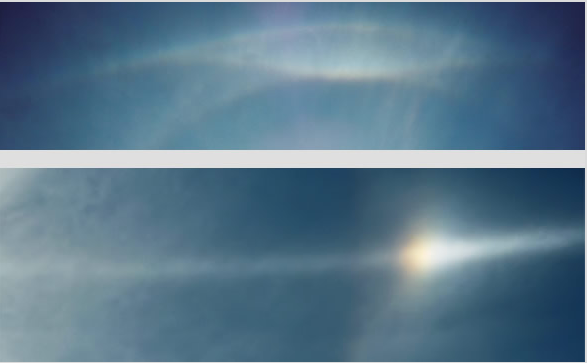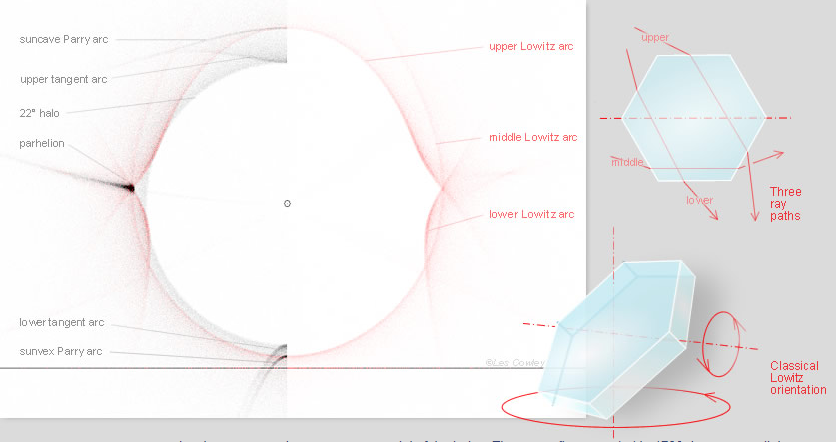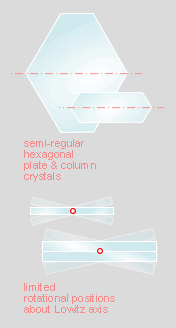Lowitz Arcs
Lowitz Arcs: A Fascinating Atmospheric Phenomenon
Lowitz arcs, an intriguing atmospheric optical phenomenon, have captivated the attention of skywatchers and scientists alike for centuries. These arcs extend upwards and downwards from the parhelion towards the 22° halo, creating a mesmerizing display in the sky. Although they were first recorded in 1790, their existence was heavily debated until the 1990s. Thanks to advancements in technology and increased interest in atmospheric optics, we now have the privilege of witnessing and documenting these rare occurrences.
Unveiling the Beauty of Lowitz Arcs
When observing Lowitz arcs, one can expect them to be faint and indistinct, making them quite challenging to spot. However, there are certain conditions that enhance the visibility of these arcs. The upper Lowitz arc, which extends up from the 22-degree halo, can be more pronounced and visible when the sun is between 15 and 30 degrees high. This range provides the best opportunity to witness the ethereal beauty of a Lowitz arc.
Exploring the Characteristics of Lowitz Arcs
To identify a Lowitz arc, one traditionally looks for arcs extending from a sundog to the nearby 22° halo. However, there are additional features to watch out for during your search. The 22° halo at 10 and 2 o'clock is often brighter where a Lowitz arc intersects it. Conversely, the 22° halo appears weaker next to the parhelion. The upper Lowitz arc is most noticeable above the 22° halo, adding to its enchanting allure.
Lowitz arcs are closely related to Parry arcs, and the upper Lowitz arc always tangentially intersects a suncave Parry. To catch a glimpse of a Lowitz arc, it is essential to examine the region between a Parry arc and upper tangent arc. With a stroke of luck, one may witness a faint Lowitz arc gracefully curving downwards. Additionally, when the sun is low and the twin 'V's of an upper tangent and suncave Parry are visible, keep an eye out for a middle Lowitz arc touching the Parry.
Unraveling the Mystery of Lowitz Arc Formation
The classical explanation for the formation of Lowitz arcs revolves around Lowitz-oriented plate crystals. These crystals have the unique ability to rotate or take all rotational positions about a near-horizontal 'Lowitz axis'. Lowitz rays pass between two prism side faces inclined at 60°, resulting in the production of upper, middle, and lower arcs. However, the rarity of these arcs suggests that there may be other factors at play.
Recent studies have shed new light on the formation of Lowitz arcs. Marko Riikonen et al. analyzed several displays with well-defined arcs and concluded that the classical explanation alone was insufficient. Their findings indicated that semi-regular hexagonal plates or prisms, rather than regular ones, better simulated the observed arc intensities. Furthermore, the extent of the arcs suggested that crystals take limited orientations about the Lowitz axis, rather than assuming all rotational positions. These discoveries indicate that there is still much to uncover about the captivating world of Lowitz arcs.
In conclusion, Lowitz arcs continue to intrigue and astound sky enthusiasts and researchers alike. These ethereal arcs, extending from the parhelion towards the 22° halo, possess a rare beauty that captivates our imagination. With advancements in technology and increased interest in atmospheric optics, we now have a greater opportunity to witness and document these mesmerizing displays. As scientists continue to delve into the mysteries of Lowitz arc formation, we eagerly await further revelations about this captivating atmospheric phenomenon.

Two aspects of a 1988 Lowitz arc display observed by Robert Gorkin at Dover, Delaware, USA.
Lowitz arcs extend upwards and downwards from the parhelion towards the 22° halo. But, as usual, they are faint and indistinct.
Much clearer is the upper Lowitz arc extending up from the 22 degree halo, crossing the upper tangent arc and meeting the Parry arc. Look in this region when the sun is 15 - 30 degrees high for the best chance to see a Lowitz.


Lowitz arcs were the most controversial of the halos. They were first recorded in 1790, but even until the 1990s their existence was doubted. Now, see the gallery, digital cameras, easy Internet communication and much increased interest in atmospheric optics combine to produce images each year. Nonetheless, Lowitz arcs remain rare. When they are seen they are usually fleeting, faint and indistinct.
Looking for a Lowitz arc? The traditional search is for arcs extending from a sundog to the nearby 22° halo. Do this, but look out for other features. The 22° halo at 10 and 2 o’clock is often brighter where a Lowitz arc touches it. The 22° halo is conversely rather weaker next to the parhelion. The upper Lowitz arc can be most evident___above___ the 22° halo.
Lowitz arcs are closely related to Parry arcs and the upper Lowitz arc is always tangential to a suncave Parry. Therefore, look closely at the region between a Parry arc and upper tangent arc. With luck, a faint Lowitz arc will be seen curving downwards. When the sun is low and the twin ‘V’s of an upper tangent and suncave Parry are visible, look also for a middle Lowitz arc touching the Parry.
The classical explanation for Lowitz arc formation is via Lowitz oriented plate crystals. These ‘rotate’ or take all rotational positions about a near horizontal ‘Lowitz axis’. Lowitz rays pass between two prism side faces inclined at 60°. As with Parry arcs, there are three possible routes and for Lowitz oriented crystals they produce upper, middle and lower arcs. The Lowitz orientation is unusual and perhaps not aerodynamically very favourable. This might account for the arcs’ rarity but there may be other factors.
Recently Marko Riikonen et.al.. analysed several Lowitz displays with clear and well defined arcs and concluded that, for some, the classical explanation was not adequate. The arc relative intensities were better simulated using semi-regular hexagonal plates or prisms rather than the regular ones previously assumed. Furthermore, the observed extent of arcs suggest that crystals take limited orientations about the Lowitz axis rather than all rotational positions. The Lowitz story is not over yet.
- Riikonen, M., Cowley, L., Schroeder, M., Pekkola, M, Öhman, T. and Hinz, C.,The Lowitz Arcs, Weather, September 2007, Vol.62, No.9, pp252-6
Note: this article has been automatically converted from the old site and may not appear as intended. You can find the original article here.
Reference Atmospheric Optics
If you use any of the definitions, information, or data presented on Atmospheric Optics, please copy the link or reference below to properly credit us as the reference source. Thank you!
-
<a href="https://atoptics.co.uk/blog/lowitz-arcs/">Lowitz Arcs</a>
-
"Lowitz Arcs". Atmospheric Optics. Accessed on April 28, 2024. https://atoptics.co.uk/blog/lowitz-arcs/.
-
"Lowitz Arcs". Atmospheric Optics, https://atoptics.co.uk/blog/lowitz-arcs/. Accessed 28 April, 2024
-
Lowitz Arcs. Atmospheric Optics. Retrieved from https://atoptics.co.uk/blog/lowitz-arcs/.